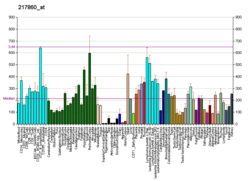NDUFA10
NADH dehydrogenase [ubiquinone] 1 alpha subcomplex subunit 10 is an enzyme that in humans is encoded by the NDUFA10 gene.[5][6] The NDUFA10 protein is a subunit of NADH dehydrogenase (ubiquinone), which is located in the mitochondrial inner membrane and is the largest of the five complexes of the electron transport chain.[7][8] Mutations in subunits of NADH dehydrogenase (ubiquinone), also known as Complex I, frequently lead to complex neurodegenerative diseases such as Leigh's syndrome.[5] Furthermore, reduced NDUFA10 expression levels due to FOXM1-directed hypermethylation are associated with human squamous cell carcinoma and may be related to other forms of cancer.[9]
Structure
The NDUFA10 gene is located on the q arm of chromosome 2 in position 37.3 and spans 68,031 base pairs.[5] The gene produces a 41 kDa protein composed of 355 amino acids.[10] NDUFA10 is a subunit of the enzyme NADH dehydrogenase (ubiquinone), the largest of the respiratory complexes. The structure is L-shaped with a long, hydrophobic transmembrane domain and a hydrophilic domain for the peripheral arm that includes all the known redox centers and the NADH binding site.[7] It has been noted that the N-terminal hydrophobic domain has the potential to be folded into an alpha helix spanning the inner mitochondrial membrane with a C-terminal hydrophilic domain interacting with globular subunits of Complex I. The highly conserved two-domain structure suggests that this feature is critical for the protein function and that the hydrophobic domain acts as an anchor for the NADH dehydrogenase (ubiquinone) complex at the inner mitochondrial membrane. NDUFA10 is one of about 31 hydrophobic subunits that form the transmembrane region of Complex I, but it is an accessory subunit that is believed not to be involved in catalysis.[11] The predicted secondary structure is primarily alpha helix, but the carboxy-terminal half of the protein has high potential to adopt a coiled-coil form. The amino-terminal part contains a putative beta sheet rich in hydrophobic amino acids that may serve as mitochondrial import signal.[5][8][12]
Function
The human NDUFA10 gene codes for a subunit of Complex I of the respiratory chain, which transfers electrons from NADH to ubiquinone.[5] NADH binds to Complex I and transfers two electrons to the isoalloxazine ring of the flavin mononucleotide (FMN) prosthetic arm to form FMNH2. The electrons are transferred through a series of iron-sulfur (Fe-S) clusters in the prosthetic arm and finally to coenzyme Q10 (CoQ), which is reduced to ubiquinol (CoQH2). The flow of electrons changes the redox state of the protein, resulting in a conformational change and pK shift of the ionizable side chain, which pumps four hydrogen ions out of the mitochondrial matrix.[7]
Clinical significance
NDUFA10 demonstrated significantly downregulated mRNA expression levels in human squamous cell carcinoma, due to FOXM1-induced hypermethylation. FOXM1 is a known oncogene that has been implicated in all human cancer types. It operates by inhibiting tumor suppressor genes through promoter hypermethylation, among other mechanisms.[9]
References
- 1 2 3 ENSG00000281434 GRCh38: Ensembl release 89: ENSG00000130414, ENSG00000281434 - Ensembl, May 2017
- 1 2 3 GRCm38: Ensembl release 89: ENSMUSG00000026260 - Ensembl, May 2017
- ↑ "Human PubMed Reference:".
- ↑ "Mouse PubMed Reference:".
- 1 2 3 4 5 "Entrez Gene: NDUFA10 NADH dehydrogenase (ubiquinone) 1 alpha subcomplex, 10".
- ↑ Loeffen JL, Triepels RH, van den Heuvel LP, Schuelke M, Buskens CA, Smeets RJ, Trijbels JM, Smeitink JA (Dec 1998). "cDNA of eight nuclear encoded subunits of NADH:ubiquinone oxidoreductase: human complex I cDNA characterization completed". Biochemical and Biophysical Research Communications. 253 (2): 415–22. PMID 9878551. doi:10.1006/bbrc.1998.9786.
- 1 2 3 Voet D, Voet JG, Pratt CW (2013). "Chapter 18". Fundamentals of biochemistry: life at the molecular level (4th ed.). Hoboken, NJ: Wiley. pp. 581–620. ISBN 978-0-470-54784-7.
- 1 2 Emahazion T, Beskow A, Gyllensten U, Brookes AJ (Nov 1998). "Intron based radiation hybrid mapping of 15 complex I genes of the human electron transport chain". Cytogenetics and Cell Genetics. 82 (1-2): 115–9. PMID 9763677. doi:10.1159/000015082.
- 1 2 Teh MT, Gemenetzidis E, Patel D, Tariq R, Nadir A, Bahta AW, Waseem A, Hutchison IL (2012). "FOXM1 induces a global methylation signature that mimics the cancer epigenome in head and neck squamous cell carcinoma". PLOS ONE. 7 (3): e34329. PMC 3312909
 . PMID 22461910. doi:10.1371/journal.pone.0034329.
. PMID 22461910. doi:10.1371/journal.pone.0034329. - ↑ "NDUFA10 - NADH dehydrogenase [ubiquinone] 1 alpha subcomplex subunit 10". Cardiac Organellar Protein Atlas Knowledgebase (COPaKB).
- ↑ "NDUFA10 - NADH dehydrogenase [ubiquinone] 1 alpha subcomplex subunit 10". UniProt.org. The UniProt Consortium.
- ↑ Ton C, Hwang DM, Dempsey AA, Liew CC (Dec 1997). "Identification and primary structure of five human NADH-ubiquinone oxidoreductase subunits". Biochemical and Biophysical Research Communications. 241 (2): 589–94. PMID 9425316. doi:10.1006/bbrc.1997.7707.
Further reading
- Smeitink J, van den Heuvel L (Jun 1999). "Human mitochondrial complex I in health and disease". American Journal of Human Genetics. 64 (6): 1505–10. PMC 1377894
 . PMID 10330338. doi:10.1086/302432.
. PMID 10330338. doi:10.1086/302432. - Ma J, Dempsey AA, Stamatiou D, Marshall KW, Liew CC (Mar 2007). "Identifying leukocyte gene expression patterns associated with plasma lipid levels in human subjects". Atherosclerosis. 191 (1): 63–72. PMID 16806233. doi:10.1016/j.atherosclerosis.2006.05.032.
- Gevaert K, Goethals M, Martens L, Van Damme J, Staes A, Thomas GR, Vandekerckhove J (May 2003). "Exploring proteomes and analyzing protein processing by mass spectrometric identification of sorted N-terminal peptides". Nature Biotechnology. 21 (5): 566–9. PMID 12665801. doi:10.1038/nbt810.
- Baens M, Chaffanet M, Aerssens J, Cassiman JJ, Marynen P (May 1994). "Assignment of the gene for the human proliferating cell nucleolar protein P120 (NOL1) to chromosome 12p13 by fluorescence in situ hybridization and polymerase chain reaction with somatic cell hybrids". Genomics. 21 (1): 296–7. PMID 8088812. doi:10.1006/geno.1994.1267.
This article incorporates text from the United States National Library of Medicine, which is in the public domain.




